Projects
Here are listing of my current and completed projects.
Current Projects
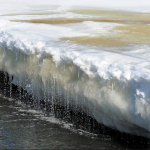 A substantial fraction of meltwater of the Greenland ice sheet is retained in firn (liquid or refrozen) rather than running off into the ocean. Unusually thick, near-surface, ice lenses have recently been discovered in the firn and are thought to be the result of exceptionally large recent melt events. This suggests that the larger volumes of meltwater produced in recent years may have been prevented from percolating into deeper firn layers, as has typically been observed in the past, and have instead run off immediately. As a result, a qualitatively different and new ’state’ of the firn has to be taken into account when attempting to quantify the mass balance of the ice sheet, and estimates based on our current state of knowledge are probably subject to larger uncertainty than previously thought. Refreezing, as the mechanism which creates impenetrable ice lenses, emerges as a crucial process in the redistribution of surface runoff and therefore in the determination of surface mass balance (SMB) of the Greenland ice sheet. To quantify this impact on the current and future SMB, this project will combine detailed field observations in the Kangerlussaq section of the Greenland ice sheet with numerical modeling of the relevant components of the climate system. Project goals are: 1) to investigate the changes and quantify the spatio-temporal variability of the firn by analyzing shallow firn cores and subsurface data at selected sites covering a wide range of elevations and climatic conditions, and compare these new observations to similar data from past decades and remotely sensed observations of firn structures; 2) to quantify the role of refreezing on the SMB with the help of a regional climate model and a high-resolution distributed energy balance model, both of which include a sub-surface snow/firn model; 3) to perform simulations of the spatio-temporal evolution of the SMB with an improved representation of refreezing process under different emission scenarios through the year 2100.
A substantial fraction of meltwater of the Greenland ice sheet is retained in firn (liquid or refrozen) rather than running off into the ocean. Unusually thick, near-surface, ice lenses have recently been discovered in the firn and are thought to be the result of exceptionally large recent melt events. This suggests that the larger volumes of meltwater produced in recent years may have been prevented from percolating into deeper firn layers, as has typically been observed in the past, and have instead run off immediately. As a result, a qualitatively different and new ’state’ of the firn has to be taken into account when attempting to quantify the mass balance of the ice sheet, and estimates based on our current state of knowledge are probably subject to larger uncertainty than previously thought. Refreezing, as the mechanism which creates impenetrable ice lenses, emerges as a crucial process in the redistribution of surface runoff and therefore in the determination of surface mass balance (SMB) of the Greenland ice sheet. To quantify this impact on the current and future SMB, this project will combine detailed field observations in the Kangerlussaq section of the Greenland ice sheet with numerical modeling of the relevant components of the climate system. Project goals are: 1) to investigate the changes and quantify the spatio-temporal variability of the firn by analyzing shallow firn cores and subsurface data at selected sites covering a wide range of elevations and climatic conditions, and compare these new observations to similar data from past decades and remotely sensed observations of firn structures; 2) to quantify the role of refreezing on the SMB with the help of a regional climate model and a high-resolution distributed energy balance model, both of which include a sub-surface snow/firn model; 3) to perform simulations of the spatio-temporal evolution of the SMB with an improved representation of refreezing process under different emission scenarios through the year 2100.
Funding Agency: National Science Foundation
Collaborators: Regine Hock (University of Alaska Fairbanks), Marco Tedesco (Lamont Doherty Earth Observatory)
Completed Projects
-
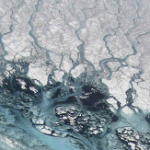 The production, transport, and export of meltwater generated across the surface of the Greenland ice sheet is critically important to our understanding of global sea level rise, yet remains one of the least studied hydrologic processes on Earth. Each summer, a complex system of thermally eroded supraglacial streams, rivers, melt ponds, lakes and moulins develops across wide expanses of the GrIS ablation zone. This meltwater undergoes a range of hydrologic processes semi-analogous to those on land, for example collecting in melt ponds and firn aquifers, or moving through coalescent water tracks and streams to form torrential supraglacial rivers flowing over the ice surface. Most if not all of these large rivers eventually sink into moulins, incised box canyons, or drained lake basins, before their runoff ultimately reappears in terrestrial proglacial rivers and sediment rich plumes entering the sea. In this project, we will investigate supraglacial rivers to understand their role in Greenland ice sheet mass balance and impacts on global sea levels.
The production, transport, and export of meltwater generated across the surface of the Greenland ice sheet is critically important to our understanding of global sea level rise, yet remains one of the least studied hydrologic processes on Earth. Each summer, a complex system of thermally eroded supraglacial streams, rivers, melt ponds, lakes and moulins develops across wide expanses of the GrIS ablation zone. This meltwater undergoes a range of hydrologic processes semi-analogous to those on land, for example collecting in melt ponds and firn aquifers, or moving through coalescent water tracks and streams to form torrential supraglacial rivers flowing over the ice surface. Most if not all of these large rivers eventually sink into moulins, incised box canyons, or drained lake basins, before their runoff ultimately reappears in terrestrial proglacial rivers and sediment rich plumes entering the sea. In this project, we will investigate supraglacial rivers to understand their role in Greenland ice sheet mass balance and impacts on global sea levels.Funding Agency: National Aeronautics and Space Administration (NASA)
Collaborators: L. C. Smith (UCLA) -
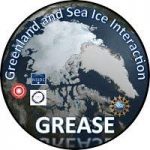 The Arctic Ocean is rapidly losing its summer sea ice cover, leading to anomalous warming of the overlying atmosphere in autumn. Concurrent with sea ice loss are negative trends in the Greenland ice sheet mass balance, with increased surface melt/ablation and discharge rates. These changes are of great socioeconomic concern as continued negative trends in the extent of floating sea ice cover and ice sheet mass are likely to have widespread impacts on climate and global sea levels. The possibility that the Arctic is shifting to a substantially different climate state, such as the dominance of seasonal versus perennial sea ice, implies that our existing knowledge about Arctic system characteristics and interactions may become increasingly less valid. Our work seeks a better understanding of how changes in different components of the Arctic, such as the sea ice cover and ice sheet, interact through the integrating properties of the overlying atmosphere and how these interactions and resulting regional effects might evolve in the future.
The Arctic Ocean is rapidly losing its summer sea ice cover, leading to anomalous warming of the overlying atmosphere in autumn. Concurrent with sea ice loss are negative trends in the Greenland ice sheet mass balance, with increased surface melt/ablation and discharge rates. These changes are of great socioeconomic concern as continued negative trends in the extent of floating sea ice cover and ice sheet mass are likely to have widespread impacts on climate and global sea levels. The possibility that the Arctic is shifting to a substantially different climate state, such as the dominance of seasonal versus perennial sea ice, implies that our existing knowledge about Arctic system characteristics and interactions may become increasingly less valid. Our work seeks a better understanding of how changes in different components of the Arctic, such as the sea ice cover and ice sheet, interact through the integrating properties of the overlying atmosphere and how these interactions and resulting regional effects might evolve in the future.Funding Agency: National Science Foundation
Collaborators: J. Stroeve (NSIDC), M. Tedesco (CCNY) -
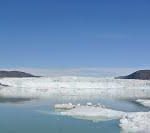 While the potential impact of increasing meltwater from Greenland on global sea level is clear, another important implication is its potential impact on coastal ocean physics, biogeochemistry, and ecology. Our interdisciplinary project seeks to understand how increasing meltwater runoff from the west Greenland Ice Sheet (GrIS) affects ocean productivity in the coastal waters of Greenland. In particular, we aim to understand how freshwater, sediment, and nutrient input from ice sheet runoff and surface fluxes impact the evolution of seasonal stratification and ocean productivity differentially along the latitudinal gradient from the Labrador Sea to the Northwater polynya.
While the potential impact of increasing meltwater from Greenland on global sea level is clear, another important implication is its potential impact on coastal ocean physics, biogeochemistry, and ecology. Our interdisciplinary project seeks to understand how increasing meltwater runoff from the west Greenland Ice Sheet (GrIS) affects ocean productivity in the coastal waters of Greenland. In particular, we aim to understand how freshwater, sediment, and nutrient input from ice sheet runoff and surface fluxes impact the evolution of seasonal stratification and ocean productivity differentially along the latitudinal gradient from the Labrador Sea to the Northwater polynya.Funding Agency: National Aeronautics and Space Administration (NASA)
Collaborators: T. Mote (U Georgia), K. Arrigo (Stanford U.), R. Castelao (U Georgia), M Tedesco (CCNY), P. Yaeger (U Georgia) -
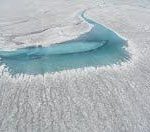 This project investigates the hydrology of the Greenland ice sheet. This is a very new and exciting area of cryospheric research. Each summer, a complex system of supraglacial meltwater lakes, streams and rivers develops across wide expanses of the ablation surface, up to approximately 1400 m elevation. An undetermined volume of this meltwater vanishes into the ice sheet via disappearing moulins (conduits), sinking streams, crevasses, fractures, and drained lakes. While present across large areas of the ice sheet, this complex hydrologic system has barely been studied. This knowledge gap introduces uncertainties in our understanding of current and future ice sheet mass balance – both from direct mass losses via water runoff, and the influence that meltwater can exert upon ice-flow dynamics.
This project investigates the hydrology of the Greenland ice sheet. This is a very new and exciting area of cryospheric research. Each summer, a complex system of supraglacial meltwater lakes, streams and rivers develops across wide expanses of the ablation surface, up to approximately 1400 m elevation. An undetermined volume of this meltwater vanishes into the ice sheet via disappearing moulins (conduits), sinking streams, crevasses, fractures, and drained lakes. While present across large areas of the ice sheet, this complex hydrologic system has barely been studied. This knowledge gap introduces uncertainties in our understanding of current and future ice sheet mass balance – both from direct mass losses via water runoff, and the influence that meltwater can exert upon ice-flow dynamics.Funding Agency: National Aeronautics and Space Administration (NASA)
Collaborators: L. C. Smith (UCLA), Y. Sheng (UCLA), C. Legleiter (U. Wyoming)